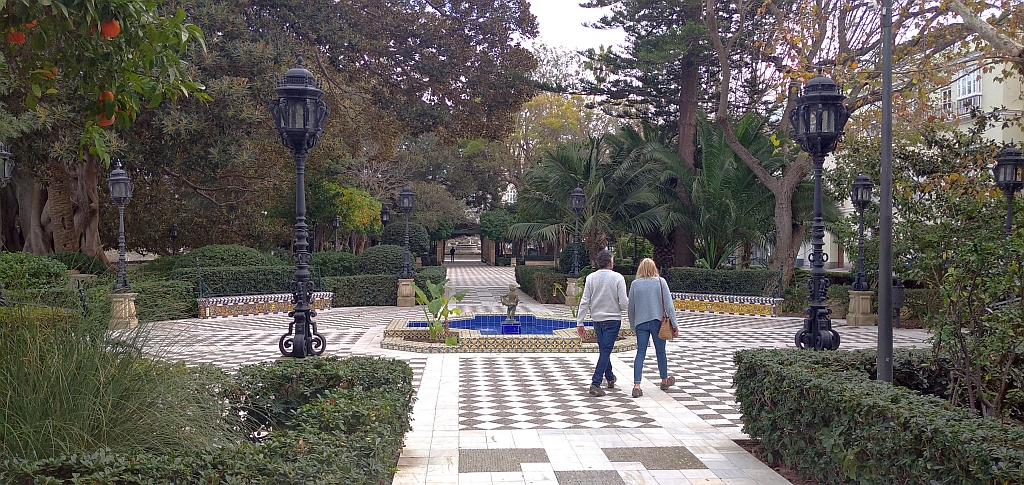The Alameda Apodaca y Marqués de Comillas is a beautiful promenade in Cádiz that borders the historic city center to the south and faces the bay of Cádiz and nearby towns like El Puerto de Santa María and Rota. The promenade is landscaped in a romantic style with a linear layout marked by the regionalist style of the early 20th century, featuring glazed ceramics from Seville and wrought iron on benches and lampposts.
The gardens are situated between two significant constructions – the Baluarte de la Candelaria and the walls of San Carlos, both built in the late 18th century as a defense for the northwest front of the city. The promenade’s east side is named after Cádiz admiral Juan José Ruiz de Apodaca y Eliza, while the west side is named after Claudio López Bru, second Marqués de Comillas.
The gardens design
The design presents a slightly broken linear layout on its plan, marked by the prevailing regionalist style at the beginning of the 20th century, embodied by the architect Juan Talavera, with the use of Sevillian glazed ceramics and wrought iron on benches and lampposts, as features characteristic. The fountains stand out for their beauty, both the one located on the side of the Baluarte next to the enormous Ficus, and those inside the garden built with ceramics from Triana.

One of the areas that make up the garden is called “Glorieta Carlos Edmundo de Ory,” in honor of the poet born in Cádiz. It has a sculpture of the writer and a pedestal with his name located in the center of it. At the west end of the park, there is a brightly colored polychrome tile fountain, and the two octagonal squares that exist in the Alameda are adorned with two low geometrically shaped fountains with tiles.
Planting scheme and the most photographed trees in Cádiz
The Alameda’s lush vegetation is a significant feature, with deciduous trees such as plane trees planted near the avenue and ornamental and monumental trees near the sea. There are several flower beds with different shapes that are delimited by hedges of species such as thuja, pitosporum and privet.
There are two magnificent specimens of Ficus macrophylla, planted at the beginning of the 20th century. (Don’t forget to visit the other two down by the Caleta beach: https://visitingcadiz.com/the-famous-strangler-figs-of-cadiz/)
There are also two specimens of Laurel de Indias about 75 years old, two 35-year-old dragon trees, two ombú trees, over 40 years old, and a Chinese fan palm 80 years old.
Statues and busts
The Alameda Apodaca features numerous busts dedicated to influential figures, particularly from Latin America. Due to its sculptures and the presence of American species, the promenade is known as the Balcony of the Bay of Cádiz.
Among the notable figures honored with busts are the Nicaraguan poet Rubén Darío, the Grand Admiral of Peru. The national hero Don Miguel Grau Seminario, The Cuban politician and poet José Martí who created the Revolutionary Party and organized the 1895 War against the Spanish colonial army. The Dominican politician and liberator Juan Pablo Duarte. The Chilean general José Miguel Carrera The illustrious Puerto Rican sailor and Deputy of the Cortes of Cádiz in 1812 Ramón Power y Giralt. The politician and military man Juan Pablo Duarte who is considered one of the Founding Fathers of the Dominican Republic. The Filipino national hero José Rizal, and the Cádiz painter Francisco Prieto.
See more parks and gardens in Cádiz here: https://visitingcadiz.com/parks-and-gardens/
Alameda Apodaca y Marqués de Comillas in Cádiz: Frequently Asked Questions
The Alameda Apodaca is renowned for its romantic garden design, fountains, sculptures, and views of the Bay of Cádiz. Often called the “Balcony of the Bay,” it’s a cultural landmark that blends history with natural beauty. More details are highlighted in the full article.
The gardens were designed by architect Juan Talavera in the early 20th century. His regionalist style is seen in the Sevillian glazed ceramics, wrought-iron benches, and decorative lampposts that make the promenade so distinctive.
Visitors can enjoy lush vegetation, including plane trees, ficus macrophylla, laurel de Indias, dragon trees, ombú trees, and Chinese fan palms. Flower beds lined with hedges add to the charm, making it one of the greenest spots in Cádiz.
The promenade overlooks the Bay of Cádiz and includes sculptures of Latin American and Spanish figures, reflecting its cultural ties. Combined with its American tree species, it earned the nickname “Balcony of the Bay.”
Busts honour notable figures such as Rubén Darío, José Martí, Juan Pablo Duarte, José Rizal, and Cádiz painter Francisco Prieto. These monuments highlight Cádiz’s historical links with Latin America and its role in global cultural exchange.
I’ve been living in this lovely area of Western Andalucia for the last 20 years or so and dedicate most of my time to the running of English language tourist information websites for the towns of Cádiz, Ronda, Grazalema, the famous or infamous Caminito del Rey, and also Wildside Holidays, which promotes sustainable and eco-friendly businesses running wildlife and walking holidays in Spain. My articles contain affiliate links that will help you reserve a hotel, bus, train or activity in the area. You don’t pay more, but by using them you do support this website. Thankyou!
